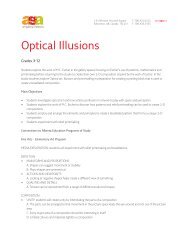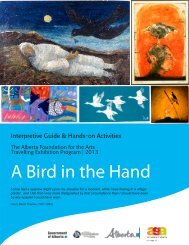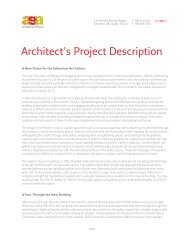Down on the Farm - Art Gallery of Alberta
Down on the Farm - Art Gallery of Alberta
Down on the Farm - Art Gallery of Alberta
- No tags were found...
You also want an ePaper? Increase the reach of your titles
YUMPU automatically turns print PDFs into web optimized ePapers that Google loves.
The <strong>Alberta</strong> Foundati<strong>on</strong> for <strong>the</strong> <strong>Art</strong>s Travelling Exhibiti<strong>on</strong> ProgramPhotography: The Modern View: A Surveyc<strong>on</strong>tinuedPablo PicassoStill Life with Bowl <strong>of</strong> Fruit, 1912Philadelphia Museum <strong>of</strong> <strong>Art</strong>Pablo PicassoPortrait <strong>of</strong> a Girl 1914Musee Nati<strong>on</strong>al d’<strong>Art</strong> ModerneCentre Georges Pompidou, ParisIn syn<strong>the</strong>tic cubism, <strong>the</strong> picture plane lies in fr<strong>on</strong>t <strong>of</strong> <strong>the</strong> picture plane. This re-definiti<strong>on</strong> <strong>of</strong>space, so different from <strong>the</strong> Renaissance principle <strong>of</strong> three-dimensi<strong>on</strong>al illusi<strong>on</strong> that haddominated academic teaching for centuries, would have a pr<strong>of</strong>ound effect <strong>on</strong> <strong>the</strong> development <strong>of</strong>abstracti<strong>on</strong> in art and was a true landmark in <strong>the</strong> history <strong>of</strong> painting.Influenced by <strong>the</strong> practices <strong>of</strong> Impressi<strong>on</strong>ism, Fauvism and Cubism, artists graduallydeveloped <strong>the</strong> idea that colour, line, form and texture could be <strong>the</strong> actual subjects <strong>of</strong> apainting and form <strong>the</strong> essential characteristics <strong>of</strong> art. Adhering to this, WassilyKandinsky and Piet M<strong>on</strong>drian developed <strong>the</strong> first pure abstract works in 20th century art.For both Kandinsky and M<strong>on</strong>drian, abstracti<strong>on</strong> was a search for truths behindappearances, expressed in a pure visual vocabulary stripped <strong>of</strong> representati<strong>on</strong>alreferences.Wassily Kandinsky (1866-1944) was born in Moscow. Originally trained in law and ec<strong>on</strong>omics,Kandinsky started painting at <strong>the</strong> age <strong>of</strong> 30 and, in 1896, moved to Germany to study artfull-time. After a brief return to Russia (1914-1921) Kandinsky returned to Germany where hetaught at <strong>the</strong> Bauhaus school <strong>of</strong> art and architecture until it was closed by <strong>the</strong> Nazis in 1933. He<strong>the</strong>n moved to France where he remained for <strong>the</strong> rest <strong>of</strong> his life.Kandinsky’s creati<strong>on</strong> <strong>of</strong> purely abstract work followed a l<strong>on</strong>g period <strong>of</strong> development andmaturati<strong>on</strong> <strong>of</strong> <strong>the</strong>oretical thought based <strong>on</strong> his pers<strong>on</strong>al artistic experience. At first influenced byboth pointillism and <strong>the</strong> Fauve artists, by 1922 geometrical elements had taken <strong>on</strong> increasingimportance in his paintings. Kandinsky was also extremely influenced by music as heAFA Travelling Exhibiti<strong>on</strong> Program, Edm<strong>on</strong>t<strong>on</strong>, AB. Ph: 780.428.3830 Fax: 780.421.0479youraga.ca
















